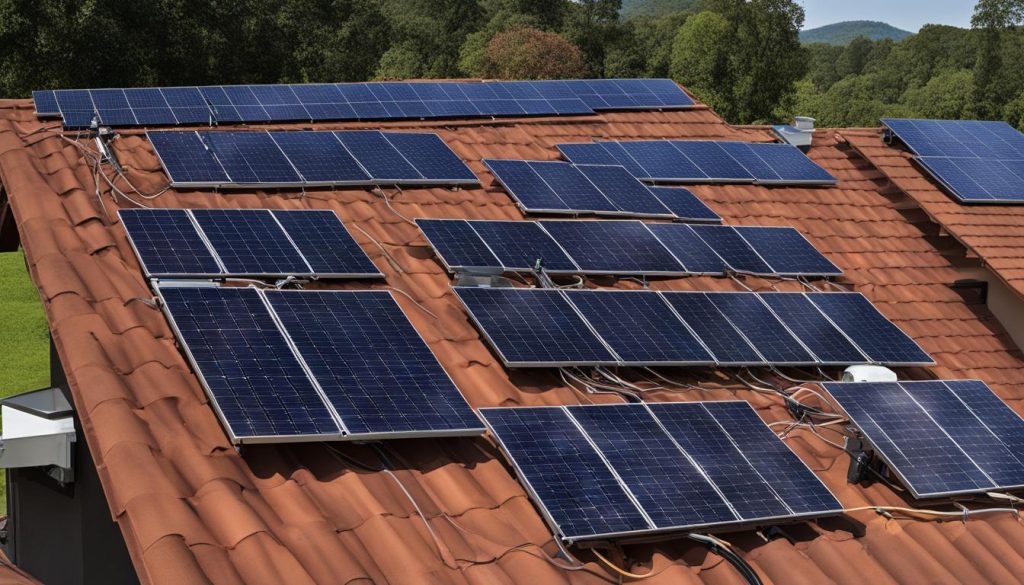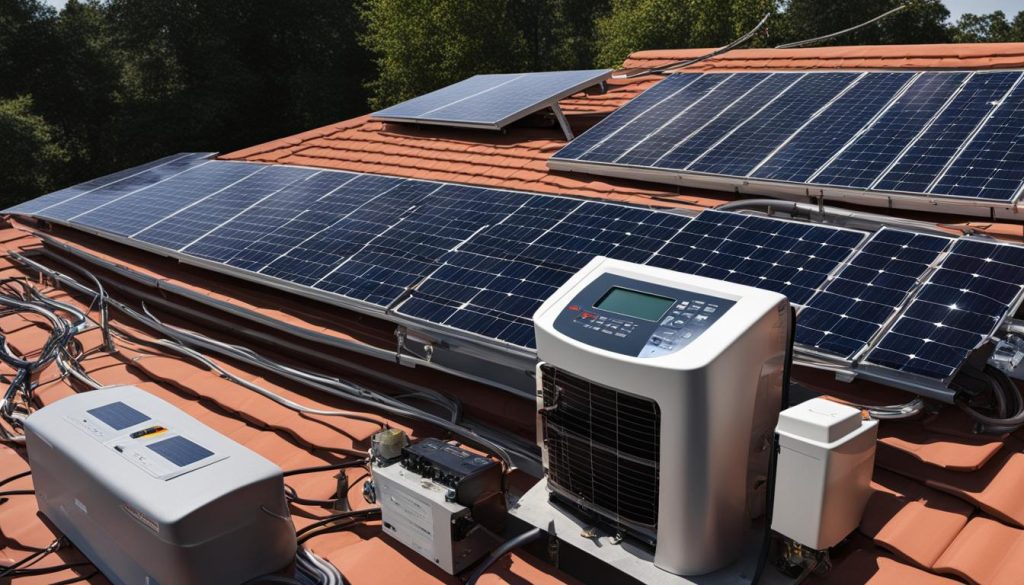Welcome to our simple guide on how does solar grid tie work. In this article, we will dive into the world of grid-tied solar systems, exploring the ins and outs of this popular renewable energy solution. From the role of grid-tied solar panels to the functionality of a solar grid tie inverter, we’ll cover it all.
But first, let’s understand what exactly a grid-tied solar system entails. Essentially, it’s a solar power system that is connected to the electric grid. This means that instead of relying solely on the energy generated by your solar panels, you can tap into the local infrastructure to meet your energy needs.
Now that you have a basic understanding, let’s delve deeper into how grid-tied solar panels work, the components involved, and the benefits they offer. By the end of this guide, you’ll have a clearer picture of how a solar grid tie system can be a valuable addition to your home.
What Does Grid-Tied Solar Mean?
Grid-tied solar panels, also known as grid-tie, on-grid, or utility-interactive panels, are photovoltaic energy systems that are connected to the electric grid. Unlike thermal solar panels that primarily heat water, grid-tied solar panels generate electricity and transmit it through the power lines connected to your home. Most residential solar installations today are grid-tied, except for off-grid installations in remote locations.
Grid-tied solar panels allow homeowners to take advantage of the existing electrical infrastructure in their area. When the sun is shining, these panels generate electricity that can be used to power your home. Any excess electricity produced during the day is sent back to the grid, allowing other households to benefit from it. In return, you receive credits on your electricity bill, reducing your overall energy costs.
Being grid-tied offers several advantages. First, it eliminates the need for costly battery storage systems, as you can rely on the grid for electricity during times when your solar panels aren’t producing enough power. Second, it provides a more reliable source of electricity compared to off-grid systems that solely rely on solar power. Lastly, grid-tied solar panels contribute to a more sustainable energy future by reducing the reliance on fossil fuels and lowering carbon emissions.
What Does Grid-Tied Solar Mean?
How Do Grid-Tied Solar Panels Work?
Grid-tied solar panels harness the power of sunlight to generate electricity. These panels are equipped with photovoltaic cells that convert sunlight into direct current (DC) electricity. However, since most homes and businesses operate on alternating current (AC) electricity, an essential component of a grid-tied solar system is the grid-tie inverter.
The grid-tie inverter converts the DC electricity produced by the solar panels into AC electricity, which can be used to power your home or business. In addition, when the solar panels generate more electricity than is being consumed, the excess energy can be sent back to the grid. This process is made possible by net metering, which allows for the tracking of the electricity sent to the grid and may result in credits on your electricity bill.
Components of a Grid-Tied Solar System
A grid-tied solar system consists of several key components besides the solar panels and grid-tie inverter. Firstly, the solar panel installation includes mounting equipment that securely installs the panels on rooftops or open spaces for maximum exposure to sunlight. Additionally, a smart utility meter is used to monitor energy production and consumption, providing valuable information on the performance of your solar system. Finally, power disconnects are installed to ensure safety during emergencies or when repairs are needed.


Overall, grid-tied solar panels work by harnessing sunlight, converting it into usable electricity, and allowing for the efficient use and potential export of energy to the grid. By understanding the components and functionality of a grid-tied solar system, you can make informed decisions about adopting this sustainable and cost-effective energy solution.
Components of a Grid-Tied Solar System
A grid-tied solar energy system consists of several key components that work together to harness and convert solar energy into usable electricity. Understanding these components is essential when considering the installation of a grid-tied solar system for your home or business.
Solar Panels
The most visible and crucial component of a grid-tied solar system is the solar panels themselves. These panels are made up of photovoltaic cells that capture the sun’s energy and convert it into direct current (DC) electricity. The number of solar panels required will depend on the energy needs of your property and the available space for installation.
Mounting Equipment
To ensure the optimal performance of your solar panels, they must be securely installed on rooftops or open spaces where they can receive maximum sunlight exposure. This is where mounting equipment comes into play. Mounting equipment includes brackets, rails, and other hardware that securely attach the solar panels to the desired location, ensuring they are positioned at the appropriate angle for maximum energy absorption.
Grid-Tie Inverter
Next, we have the grid-tie inverter, which plays a vital role in a grid-tied solar system. As solar panels generate DC electricity, the grid-tie inverter converts this DC electricity into alternating current (AC) electricity that can be used to power your home or exported to the grid. It ensures compatibility with the electrical grid and synchronizes the energy produced by the solar panels with the utility power supply.
Smart Utility Meter and Power Disconnects
To monitor energy production and consumption, a smart utility meter is typically installed as part of the grid-tied solar system. This meter tracks the electricity generated by the solar panels and measures the energy consumed by your property. It allows for accurate billing and provides valuable insights into your energy usage.
In addition to the smart utility meter, power disconnects are essential components of a grid-tied solar system. These safety mechanisms allow for the disconnection of the solar system from the grid during emergencies or maintenance work, ensuring the safety of individuals working on the system and preventing any backfeed of electricity to the grid.


By understanding the various components of a grid-tied solar system, you can make informed decisions when considering the installation of solar panels for your home or business. Each component plays a crucial role in harnessing solar energy and converting it into usable electricity, paving the way for a greener and more sustainable future.
Grid-Tied Solar System Price
When considering installing a grid-tied solar system, it is important to understand the associated costs. The total cost of a grid-tied solar system will depend on various factors including the size of the system, the components used, and the financing options available.
On average, the cost of solar panels in the United States is around $3.30 per watt. For an 8 kW solar energy system, which is a common size for residential properties, the total cost would be approximately $26,400. It’s important to note that these figures are just estimates and prices can vary depending on your location and specific requirements.
If the upfront cost of a grid-tied solar system seems daunting, there are financing options available to help make it more affordable. Many solar providers offer financing plans such as solar loans or power purchase agreements (PPAs), which allow homeowners to pay for their solar system over time. Additionally, there are federal and state incentives, such as the federal solar tax credit, that can help further reduce the overall cost of the system.
Exploring Financing Options
When considering financing options for your grid-tied solar system, it is important to carefully evaluate the terms and conditions offered by different providers. Compare interest rates, repayment periods, and any additional fees or charges that may apply. It’s also worth consulting with a solar professional who can help guide you through the financing process and provide recommendations based on your specific needs.
Investing in a grid-tied solar system not only helps reduce your monthly electricity bills but also contributes to a greener environment. By harnessing the power of the sun, you can take advantage of renewable energy and reduce your reliance on fossil fuels. With the right financing plan in place, going solar can be a financially smart and environmentally responsible decision.


Grid-Tied Solar System Benefits
Investing in a grid-tied solar system offers numerous advantages that go beyond just saving money on your electricity bills. One key benefit is the relatively short payback period. Typically, it takes between 6 and 10 years to recoup the initial investment of a grid-tied solar system. This means that after this period, you’ll start enjoying significant savings on your energy expenses.
Grid-tied solar systems also provide long-term financial benefits. With a lifespan of 25 years or more, solar panels continue to generate clean energy even after the payback period. This translates into ongoing savings on your electricity bills, allowing you to allocate that money for other expenses or investments.
Another important advantage of grid-tied solar systems is their positive environmental impact. By harnessing the sun’s energy, solar panels reduce our reliance on fossil fuels, which significantly lowers carbon emissions and helps combat climate change. By choosing solar power, you contribute to a greener and more sustainable future.
Conclusion
In conclusion, grid-tied solar systems offer a win-win situation. You can enjoy substantial savings on your electricity bills while reducing your carbon footprint. The payback period for these systems is relatively short, and their longevity ensures that you’ll continue to reap the financial benefits for many years to come. So, embrace the power of the sun and make the switch to a clean, cost-effective, and eco-friendly grid-tied solar system.
FAQ
How does solar grid tie work?
Solar grid tie systems are connected to the electric grid and generate electricity from sunlight. The solar panels convert sunlight into DC electricity, which is then converted into AC electricity using a grid-tie inverter. This AC electricity can be used to power your home and any excess can be sent back to the grid.
What does grid-tied solar mean?
Grid-tied solar panels, also known as on-grid or utility-interactive panels, are photovoltaic energy systems that are connected to the electric grid. They rely on the local infrastructure for energy generation and can send any excess electricity back to the grid. This allows homeowners to offset their energy consumption and potentially receive credits on their electricity bills.
How do grid-tied solar panels work?
Grid-tied solar panels harness sunlight and convert it into DC electricity. This electricity is then converted into AC electricity using a grid-tie inverter. The AC electricity can be used in your home and any excess can be sent back to the grid. Net metering tracks the solar power sent to the utility grid, potentially resulting in credits on your electricity bills.
What are the components of a grid-tied solar system?
A grid-tied solar system consists of solar panels that harness sunlight, mounting equipment to securely install the panels, a grid-tie inverter to convert DC into AC electricity, a smart utility meter to monitor energy production and consumption, and power disconnects for safety during emergencies or repairs.
How much does a grid-tied solar system cost?
The total cost of a grid-tied solar system depends on factors such as system size, components used, and financing options. In the United States, the average cost of solar panels is around $3.30 per watt. For example, an 8 kW solar energy system, a common size for residential properties, would cost approximately $26,400. However, incentives like the federal solar tax credit can help reduce the overall cost.
What are the benefits of a grid-tied solar system?
Grid-tied solar systems offer several benefits. They can significantly lower electricity expenses and provide a return on investment over time. The payback period for a grid-tied solar system is typically between 6 and 10 years. Solar panels have a lifespan of 25 years or more, providing long-term savings. Additionally, grid-tied solar systems contribute to a greener environment by reducing reliance on fossil fuels and lowering carbon emissions.
